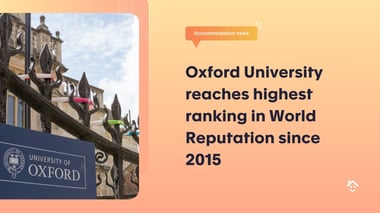A recent study by the Higher Education Policy Institute has shed light on the current state of the student accommodation market.
In recent years, the once steadfast trajectory of UK 18-year-olds enrolling in higher education has encountered a levelling off.
Despite a surge in demographic numbers, the proportion of students enrolling in higher education remained relatively stagnant, with admission figures remaining relatively unchanged at 56.2% for the 2022/23 academic cycle.
The latest data from the Universities and Colleges Admissions Service (UCAS) paints a sobering picture, indicating a marginal decline in acceptances for the incoming 2023/24 cohort, particularly pronounced among international students.
Impact of Institutional Type
The ebb and flow of undergraduate demand vary significantly across different categories of institutions. While higher tariff universities have experienced a modest uptick in domestic enrolments, they've concurrently witnessed a downturn in international admissions. In contrast, lower tariff institutions grapple with a substantial decline in acceptances, exacerbating financial strains.
For instance, the data underscores a notable divergence in acceptance trends among medium and lower tariff universities. Medium tariffs saw a 1.5% increase in acceptances for home students but 0.9% decrease for international students.
Conversely, lower tariff establishments faced a more pronounced downturn, with a noteworthy 5.2% drop in acceptances, further compounded by declines in both domestic and international student cohorts.
International Student Dynamics
The influx of international students has long been a cornerstone of student accommodation demand, with postgraduate recruitment serving as a significant growth driver.
However, recent trends suggest a notable shift in this paradigm, with signs indicating a plateau in international student numbers. Despite this, nuances abound within the data, highlighting divergent patterns across key demographics and nationalities.
For instance, while Chinese recruitment appears to have stabilized at the national level, discernible fluctuations emerge when scrutinizing institutional types. Notably, higher tariff providers continue to attract a steady stream of Chinese students, albeit with discernible drops witnessed at other institutions.
Conversely, burgeoning demand from India and Nigeria emerges as a noteworthy trend, propelled by various socio-economic factors and educational aspirations.
Financial Pressures on Universities
The fiscal landscape within higher education institutions reflects a complex interplay of stagnant home fee income and diminishing government support.
With traditional revenue streams under strain, universities have increasingly turned to international student recruitment as a financial lifeline. However, this strategy faces mounting challenges, with diminishing returns and escalating financial pressures.
The Institute for Fiscal Studies (IFS) report offers a sobering assessment of the financial constraints facing universities. In 2012/13, each undergraduate from England had the equivalent of £11,800 spent annually on teaching resources but undergraduates in 2024/25 will get just £9,600.
Against the backdrop of frozen home fee income and escalating operational costs, institutions are confronting unprecedented challenges, prompting a slew of cost-saving measures and structural adjustments.
Affordability and Housing Options
Traditionally, Purpose-Built Student Accommodation (PBSA) catered predominantly to first-year and international students, with the latter often occupying higher-end luxury options. However, returning undergraduates, particularly those from more affluent backgrounds, have become a significant demographic in PBSA.
One notable shift is the increase in direct letting of PBSA, accounting for 58% of rentals, signalling a departure from exclusive institution-led allocations. This trend is influenced by various factors, including changes in student finance and parental contributions, which have squeezed undergraduate living costs.
The IFS report highlights the decline in the value of the maintenance package for home undergraduates which has fallen by 10% in real terms since 2020-21 and is now at the lowest level it has been in seven years.
With maintenance loans dwindling in value and parental financial pressures rising, more students are compelled to seek part-time employment and incur greater debt burdens to finance their education and accommodation.
Despite these financial pressures, the proportion of commuting students has not significantly increased, indicating that the desire for a residential university experience remains strong.
You can learn more about the future trends of student accommodation here.
If you are interested in letting your property to students, accommodationforstudents.com is the no.1 student accommodation service in the UK.



